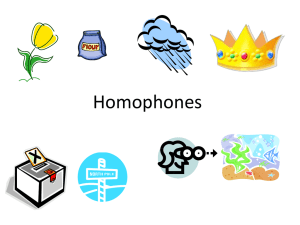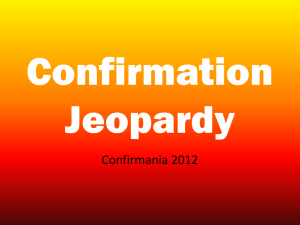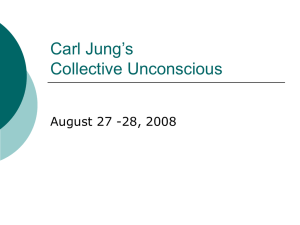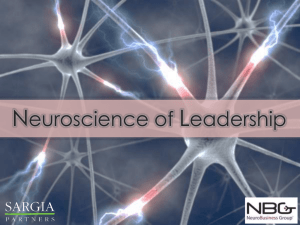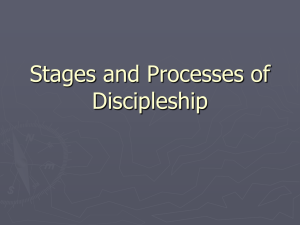Power Point Slides
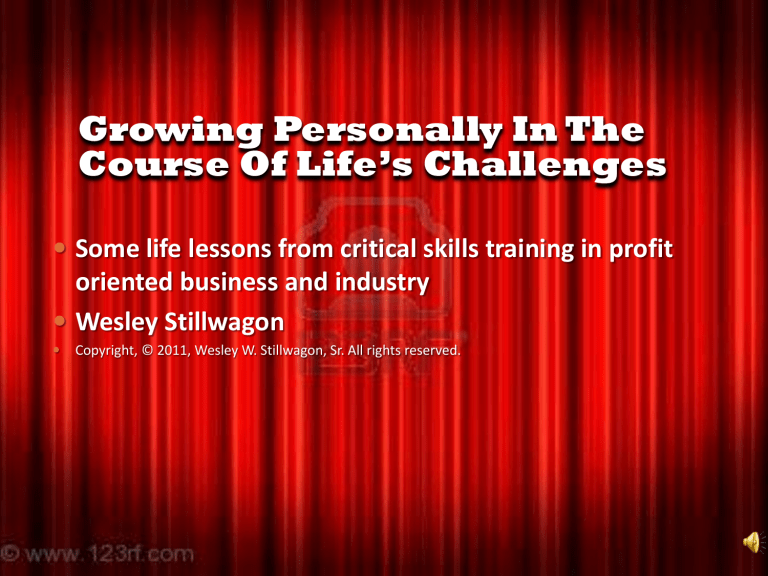
Growing Personally In The
Course Of Life’s Challenges
Some life lessons from critical skills training in profit oriented business and industry
Wesley Stillwagon
Copyright, © 2011, Wesley W. Stillwagon, Sr. All rights reserved.
“If a man is capable of living a responsible life himself, then he is conscious of his duties to the community.” Carl G. Jung, Ph.D. M.D.
Growing Personally In The Course
Of Life’s Challenges
1.
2.
3.
Objectives
Introduce and reinforce the vision of ourselves as maturing or evolving individuals;
Introduce language, concepts, and a systematic approach to:
Understanding life; and,
Responding to its opportunities, gifts, and challenges.
Introduce useful concepts, tools, and models to:
Define reasonable life growth goals;
Determine where we are with respect to those goals;
Develop a reasonable life path between where one is and where they want to be;
To track progress; and,
Confidently decide when the goals have been met.
How did I get here?
Training and
Development
Trainee Success
Given the same:
Entry path to learning;
Information;
Demonstration;
Guidance;
Critique
Feedback; and,
Motivation
Trainee Success
Given the same:
Entry path to learning;
Information;
Demonstration;
Guidance;
Critique
Feedback; and,
Motivation
Stick Him,
Dude! (Cue)
Simple Task
Stick Him,
Dude! (Cue)
Cue Process Standard
Simple Task
Cue Process Standard
Simple Task
Cue Process Standard
Simple Task
Cue Process Standard
Simple Task
Cue Process Standard
Didn’t
Work. I
Must
Review
Process!
Cue
Simple Task
Process
Didn’t Work.
I Must
Review
Process!
Standard
Simple Task
1.
2.
3.
4.
5.
Process
Wait for order to start procedure (Cue)
Wait until opponent is close enough
Stick him
Make sure he won’t cause trouble again (standard)
Go to help other team members
Cue Process Standard
Would you kindly stand close enough that I may stick you?
Simple Task
Fat chance
Dude!
Cue Process Standard
Human Cognitive
Complex
Knowledge
Skills
Attributes
KSA’s
Human Cognitive
Complex
Knowledge
Skills
Attributes
Humsn Cognitive
Complex
Knowledge Skills
Attributes
Human Cognitive
Complex
Knowledge
Occam’s Razor
Skills
Attributes
Human Cognitive
Complex
Knowledge Skills
Attributes
Human Cognitive
Complex
Knowledge
Skills
Attributes
HumanCognitive
Complex
Knowledge
Skills
Attributes
Is the Know what, know how, or know where (I.e. location and use of reference available to the job holder for competent execution of a job task.
Sergeant Major
John Oberlin,
Forth Monmouth, NJ
The Task And The Self
Cue
Tells employee to begin.
Follow
Process
Achieve
Goal
Rework
Standard
?
Copyright ©2001 Wesley W. Stillwagon. All rights reserved.
The Task And The Self
No Cue
Begun based upon
Initiative, analysis, synthesis.
Process Clear
Goal
Rework
Standard
?
Copyright ©2001 Wesley W. Stillwagon. All rights reserved.
The Task And The Self
No Cue
No
Process
Clear
Goal
Rework
Standard
?
Copyright ©2001 Wesley W. Stillwagon. All rights reserved.
The Task And The Self
No Cue
No
Process
No clear
Goal
No
Standard
Rework
Copyright ©2001 Wesley W. Stillwagon. All rights reserved.
Cognitive Process
Knowledge
Skills
Attributes
S
kills
are the actions a job holder must employ to complete the work tasks. They would use not only their knowledge but would apply the knowledge to actions necessary to achieve objectives – to create a measurable product or accomplishment.
If one is able to consistently meet the standards for the task, they are considered competent. “Competent” means that the value of their work as measured by the accomplishment consistently exceeds the cost of the behavior and resources.
“Worthy Performance”
Value of
Accomplishment
Is Grea ter than
Apparent Cost in
Resources
W = V/C*
*Thomas F. Gilbert, Ph.D.
Cognitive Process
Knowledge
Skills
Attributes
A
ttributes
Personal attributes consistently distinguish one job holder from another with equal knowledge and basic skills and may include:
Exceptional attention to detail;
Excellent interpersonal effectiveness;
Exceptional awareness of prevailing community attitude;
Excellent logic or value judgment;
Astute perception;
Willingness to take risks and to make decisions in the face of those risks;
Visual acuity;
Hearing ability
Jung’s Pebble Analogy
The Collective
The Individual
Jung’s Pebble Analogy
Color;
Shape;
Texture;
Hardness;
Weight; and,
Transparency.
KSA’s and The
Individual
Knowledge
Skills
Attributes
The Individual
Instructional Systems
Design
1.
2.
3.
4.
5.
6.
Analysis;
Report/proposal, economic justification (Cost/Benefit)
Approval
Development
Delivery
Measure against proposal performance objectives.
Fact
Work Issues and Challenges
Challenges and
Issues Outside of Work
Patterns, Purpose, and Plan
Publications:
Practical Applications:
Practical Applications:
Unconscious to Almost
Completely Conscious
“Man started from an unconscious state and has ever striven for greater consciousness. The development of consciousness is the burden, the suffering, and the blessing of mankind.” C. G. Jung,
New York Times interview, September, 1912.
Conscious
Unconscious
Adult Maturity
High
High
Level one
• No sense of self
• No sense of individuality
• Identify with gods they have projected on to the world
• Ego very weak
• Very Unconscious
• Easily influenced for good or bad
Medium
Low
Low
Slightly modified for relevance from The
Gnostic Jung, by Rober A. Segal, Published by
Mythos, The Princeton/Bollingen Series in
World Mythology
Adult Maturity
High
High
Level two
• Mainly Unconscious
• Ego Stronger
• Project on gods distinct and external to themselves
• Cannot distinguish rhetoric or innuendo from fact
Medium
Low
Low
Slightly modified for relevance from The
Gnostic Jung, by Rober A. Segal, Published by
Mythos, The Princeton/Bollingen Series in
World Mythology
Adult Maturity
High
Level three
• Ego stronger and fully integrated
• Complete denial of
Unconscious (still unconsciously project upon the world
)
High
Medium
Low
Low
Slightly modified for relevance from The
Gnostic Jung, by Rober A. Segal, Published by
Mythos, The Princeton/Bollingen Series in
World Mythology
Adult Maturity
Level four
• Individuated,
• Experienced Break Thru
• Self-actuated
• Seeking to re-connect with
Unconscious, soul, and Spirit
High
High
Medium
Low
Low
Slightly modified for relevance from The
Gnostic Jung, by Rober A. Segal, Published by
Mythos, The Princeton/Bollingen Series in
World Mythology
Unconscious to Almost
Completely Conscious
Can we ever achieve complete consciousness?
Unconscious to Almost
Completely Conscious
Unconscious to Almost
Completely Conscious
“
The world comes into being when man discovers it. But he only discovers it when he sacrifices his containment in the primal mother, the original state of unconscious.” C. G. Jung,
“Symbols of Transformation”, Collected Works,
Vol. 5, Princeton Unive rs ity Press
Used with written permission of Princeton University Press.
How Do We Get There?
Philosopher’s Gold
"My studies of alchemy may seem obscure and baffle many people, but taken symbolically
- the symbolic gold of great worth, or the transforming philosopher's stone 'lapis philosophorum' hunted for centuries by the alchemists - is to be found in man.“ Carl G.
Jung, M.D., Ph.D.
Leisurely Selfinventory
Copyright ©2001 Wesley W. Stillwagon. All rights reserved.
Language and Concepts
Concepts and
Language to
Support:
Visualization;
Understand
Defining;
Describing;
Reporting;
Diagramming;
Mapping;
Tracking;
Evaluating; and,
Quantifying
Where do we begin?
1.
2.
3.
4.
5.
Determine where you are;
Decide where you want to be;
Visualize a realistic path between those two points;
Develop a plan; and,
Begin the journey.
Copyright ©2001 Wesley W. Stillwagon. All rights reserved.
Where do we begin?
Leisurely S elfinventory
Copyright ©2001 Wesley W. Stillwagon. All rights reserved.
The Persona
Image we project to or is perceived by others
Copyright ©2001 Wesley W. Stillwagon. All rights reserved.
Where do we begin?
Partially
An
Illusion
Copyright ©2001 Wesley W. Stillwagon. All rights reserved.
The
Persona
The image we consciously and unconsciously present to others.
Identifying with The Persona
Persona
Persona
Public is the side that we show to and that is seen by others. This is part of the persona.
Persona
Copyright ©2001 Wesley W. Stillwagon. All rights reserved.
Persona
Private the side that we keep to ourselves.
Copyright ©2001 Wesley W. Stillwagon. All rights reserved.
Blind others see but of which we are un aware. This too is part of the
Persona.
Persona
Copyright ©2001 Wesley W. Stillwagon. All rights reserved.
Persona
Unknown others do not see and of which we are unaware.
Copyright ©2001 Wesley W. Stillwagon. All rights reserved.
Leisurely Self-inventory
Have we identified with the Persona?
The Ego
Copyright ©2001 Wesley W. Stillwagon. All rights reserved.
Ego
The conscious image of one’s self
The focal point to which objects of perception must relate to be “conscious”
Not the Self in total
Ego
C. G. Jung (not a verbatum quote):
a complex of ideas which constitutes the centre of the field of consciousness
it is not identical with the totality of the psyche
appears to possess a high degree of continuity and identity... (I’d like to add that we live in a world filled with people who are mainly unconscious with absolutely no idea about their uniqueness);
one complex among other complexes
distinguished between the ego and the Self,
Unconscious
covers all psychic contents or processes that are not conscious, includes more than one layer: 1) the personal and the 2) collective.
May include an interpersonal layer as well
John Steinbeck’s phalanx is the name of the influence highway of the complex called the “collective unconscious”.
An important influencing component of the totality of the human psyche called the Self
Infinitely more complex and influential concept then defined simply as the absence of consciousness.
Unconscious
If the unconscious is unknown or unobservable, how do we know it exists?
Because we can observe the influences on our
1.
perceptions,
2.
judgments,
3.
decisions, and
4.
behaviors
In manners not given to rational explanation like the appearance of words, images, powerful drives, and other influences including intuitions.
The influence of the unconscious may be demonstrated via free association surveys, slips of the tongue, and word association tests.
Leisurely Self-inventory
Seeking Perfection
Live to Work
Oriented toward the details
Happier with the face-to-face
Or
By observation others consider rational
Rely more on judgment
Prefer the plan
Prefer pursuing the objective
Prefer leading
Comfortable with sexuality
Seeking Completeness
Work to Live
Oriented to the big picture
Happier in the social
Impact on Population
Irrational (by observation)
Rely more on perceiving
Prefer considering the history
Enjoy living the Experience
Prefer serving
Uncomfortable with sexuality
Leisurely Self-inventory
Sometimes it is just as important to know who we ARE NOT as who we ARE. Knowing who we
are not provides a better definition of who we are.
Growth Perspective
Consider growth from a different perspective; that is as:
1.
2.
3.
4.
yourself as a unique Individual yourself as you relate or react in the
Interpersonal yourself as you relate or react within the
Social, Team, and Family environments by what you can or cannot do well perhaps as measured by your accomplishments
Copyright ©2001 Wesley W. Stillwagon. All rights reserved.
Leisurely Self-inventory
The moment that we consider such things, we’ve begun to build a useful Self-image or an
Ego.
Leisurely Self-inventory
Copyright ©2001 Wesley W. Stillwagon. All rights reserved.
The Ego is the known part of an individual’s Self or the part of our Self of which we may be conscious.
Leisurely Self-inventory
If we’ve begun to consider such things, we’ve started to build a useful self-image. As a result of this we will have something manageable or useful to work with as we grow.
Leisurely Self-inventory
A leisurely Self-inventory relying only on personal reflection can yield limited results.
Improve objectivity by:
• Reviewing your theories with friends and family;
• Take an objective style survey or do what you may to consider who you are as objectively as you can.
Leisurely Self-inventory
Random leisurely Self-inventory Your
Goal relying only on personal reflection can yield limited results.
• Run self-theories by friends and family;
• Take style surveys like the Myers-
Briggs Type Inventory.
Improve The Individual
Style Survey
Instruments
Popular Style/Type Surveys like
MBTI
Asks your subjective opinion, prediction, or theory regarding your response to survey question;
Produces pseudo-acronyms and limited two dimensional explanations (ESTJ, INFP);
Appeals to humanists; and
Requires consideration of more than 100 questions.
Objective Style Survey
Puts you into the situation and objectively measures results or response;
Produces results in practical and useful language;
Functional Style and Strength
Habitual attitude
Adult Maturity;
Appeals to everyone with practical language and useful results; and,
Possible to achieve in fewer questions
Jung and Steinbeck
Jung and Steinbeck
Jung and Steinbeck
The
Individual
Psyche
Functional Attributes
• Logic
• Plan
• Social
• Broad Time
• Big Picture
• Synthesis
Think Intuit
• Immediate
• Here and Now
• Details
Sense Feel
• Value
• History
• Interpersonal
Psychological Types
• Logic
• Plan
• Social
• Broad Time
• Big Picture
• Synthesis
Think Intuit
• Immediate
• Here and Now
• Details
Sense Feel
• Value
• History
• Interpersonal
Psychological Types
• Logic
• Plan
• Social
• Broad Time
• Big Picture
• Synthesis
Thinker Intuitor
• Immediate
• Here and Now
• Details
Sensor Feeler
• Value
• History
• Interpersonal
Psychological Types
• Logic
• Plan
• Social
• Broad Time
• Big Picture
• Synthesis
Thinker Intuitor
• Immediate
• Here and Now
• Details
Sensor Feeler
• Value
• History
• Interpersonal
Psychological Types
• Logic
• Plan
• Social
• Broad Time
• Big Picture
• Synthesis
Thinker Intuitor
• Immediate
• Here and Now
• Details
Sensor Feeler
• Value
• History
• Interpersonal
Psychological Types
• Logic
• Plan • Big Picture
• Social • Synthesis
Objective or
Thinker Intuitor
Extraverted
Sensor Feeler
• Immediate
• Here and Now
• Details
• Value
• History
• Interpersonal
Psychological Types
• Logic
• Plan
• Social
• Broad Time
• Big Picture
• Synthesis
Thinker Intuitor
Experience,
Subjective or
• Immediate
Feeler
• Value
• Here and Now
• Details • Interpersonal
The Phalanx
People,
History
Synthesis,
Strategy
Internal
Communication and Transactions
Logic,
Planning
Critical
Details
Possibilities,
Public Opinion
Copyright ©2001 Wesley W. Stillwagon. All rights reserved.
Psychologic al Types in play
Logic
Planning
Cold, no compassion!
T
People
F
History
Copyright ©2001 Wesley W. Stillwagon. All rights reserved.
Psychologic al Types in play
Strategy,
Long term plans
A Dreamer not a doer!
I S
Here and
Now!
Copyright ©2001 Wesley W. Stillwagon. All rights reserved.
The Phalanx
If this fails
…
People,
History
Synthesis,
Strategy
Internal
Communication and Transactions
Logic,
Planning
Critical
Details
Possibilities,
Public Opinion
Copyright ©2001 Wesley W. Stillwagon. All rights reserved.
The Phalanx
The Team Fails
Adult Maturity
High
Functional styles or types are part of our “Self” regardless of our adult maturity or individuation leve. How we treat that part of ourselves dramatically influences the quality of our lives both personally and interpersonally.
High
Medium
Low
Low
The Phalanx, Evolvement and And Type
High
Thinker
Medium
Sensor
View
Intuitor
Feeler
The Phalanx, Evolvement and And Type
High
Sensor
View
Intuitor
Feeler
The Phalanx, Evolvement and And Type
High
Convergence
Medium
Top
Intuitor
View
Feeler
The Phalanx,
Evolvement and And
High
Type
Individual Interpersonal
Medium
Less fear More effective teaming
Increased confidence Better communication
Increased knowledge,
Improved skills, and
Top
Intuitor
View
Feeler
Less friction and negative politics
Less inflated Ego influence more effective attributes
Better partnering
Improved economics
Increased independence
Convergence
Integration
Completeness
Individuated
Less supervision
Lower overhead
The Phalanx
People,
History
Logic,
Planning
Internal
Communication and Transactions
Critical
Synthesis, Possibilities,
Strategy
Public Opinion
Infinitely more powerful and effective
Details
Copyright ©2001 Wesley W. Stillwagon. All rights reserved.
The Shadow
Copyright ©2001 Wesley W. Stillwagon. All rights reserved.
Steinbeck’s Phalanx
Steinbeck’s Phalanx
"We know that with certain arrangement of atoms we might have what we would call a bar of iron. Certain other arrangements of atoms plus a mysterious principle make a living cell. Now the living cell is very sensitive to outside stimuli or tropisms. A further arrangement of cells and a very complex one may make a unit we call a man. That has been our final unit. But there have been mysterious things which could not be explained if man is the final unit. He also arranges himself into larger units, which I called the phalanx. The phalanx has its own memory-memory of the great tides when the moon was close, memory of starvations when the food in the world was exhausted. Memory of methods when numbers of his units had to be destroyed for the good of the whole, memory of the history of itself.“ John
Steinbeck, in a letter to his friend, George Albee.
Steinbeck’s Phalanx
"To the casual observer Cannery Row might have seemed a series of selfish units, each functioning alone with no reference to the others. There was little visible connection between (the bordellos), La Ida's and the
Bear Flag, the grocery (still known as Lee Chong's
Heavenly Flower Grocery), the Palace Flophouse, and
Western Biological Laboratories. The fact is that each was bound by gossamer threads of steel to all the others--hurt one, and you aroused vengeance in all. Let sadness come to one, and all wept." John Steinbeck,
“Sweet Thursday”
Steinbeck’s
Phalanx
Group, mob, etc. may take on a psychology quite different from that of its individual members
the group psychology is a (sometimes antagonistic) counterpoint to individual psychology.
The group psychology may cause individual members in a manner that they otherwise would not consider.
Steinbeck’s
Phalanx
Here I will add my own observations:
•The group psychology may have a reaction similar to a shadow between two individuals, except in this case, it is the group against the individual, or class.
•The higher the adult development, or individuation of the individual members of the group or mob, the less potential for negative or destructive influences of the phalanx on the group’s behavior. (What was wrong in Germany in the 1930s?)
John Steinbeck
“The attack on us set in motion the most powerful species drive we know—that of survival. It created direction toward which we could aim all of our vitalities—and we have great vitality. What the Axis could not understand was that the measure of our unrest was the measure of our vitality. The war was dumped in our laps; we could not avoid it, but fortunately for us, we have been given a kind of war we are peculiarly capable of fighting—a war without established technique or method, a kind of war rooted in production in which we surpass. If we ourselves had chosen the kind of war to be fought, we could not have found one more suitable to our national genius. For this is a war of transport, of machines, of mass production, of flexibility, and of inventiveness, and in each of these fields we have been pioneers if not actual inventors.” from
“Bombs Away” by John Steinbeck © 1942 John Steinbeck
The Gathering Place
Informal
Gathering Place
No invitation or schedule
Freedom to come and go as pleased
Participants may arrive harboring no expectations or desires beyond camaraderie, intellectual discourse, and friendship
Supportive and safe social environment
from “Sweet Thursday”:
“in the Palace Flophouse a little meeting occurred – occurred, because no one called it, no one planned it, and yet everyone knew what it was about.”
John Steinbeck
Jim Kent
“Doc’s Lab
Myth and Legends of Cannery
Row”
By Ed Larsh
Jim Kent
Social Capital
Jim Kent
Gathering Place
Kent’s Roles and Jung’s
Types
Think of the advantages of combining
Jung’s Types and Kent’s Gathering Place roles!!!
Copyright © James Kent, JD, All rights reserved
Jung’s Types
Kent’s Roles and Jung’s
Types
In doing so, it would enable us to
•better understanding the role player’s driving forces, perception, judgment, etc.
• predict in greater detail who would naturally accept and successfully fulfill the roles
•guide the role player or to assist them in achieving effectiveness.
A Diverse Team
People,
History
Logic,
Planning
Critical
Details
Synthesis,
Strategy
Possibilities,
Public Opinion
Diversity, Strength, and
Economy
Value of
Accomplishment
Is Grea ter than
Apparent Cost in
Resources
W = V/C*
*Thomas F. Gilbert, Ph.D.
Diversity and Strength
Hitler Tojo
The Phalanx
People,
History
If this fails
…
Synthesis,
Strategy
Internal
Communication and Transactions
Logic,
Planning
Critical
Details
Possibilities,
Public Opinion
Copyright ©2001 Wesley W. Stillwagon. All rights reserved.
Resources For
Improvement
Improve the Team Improve the Individual
Develop and Demand compliance to a list of oughts and musts;
Legislate compliance with threats of cruel punishment for violating;
Establish neighborhood compliance and oversight committees.
Provide means for selfevaluation;
Provide tools to establish individual goals, maps, paths, and plans;
Show individuals how to track and measure progress and how to manage resources.
Improve The Individual
Provide tools for self evaluation including:
Models, concepts, and tools for self-evaluation
Myers-Briggs Type Indicator (MBTI);
Other tools like Astrology from a competent Astrologist
Improve The Individual
Provide
Tools, models, and concepts to establish individual goals, maps, paths, and plans;
Determine if goals are reasonable;
Techniques to define maps and paths; and,
Techniques for planning a reasonable development path.
Improve The Individual
Provide tools to:
track and measure progress;
manage resources.
Astrology
More important today than ever
A key self-discovery tool for Individuation
Discover
who you are where you want to be and how to get there
Useful in mapping, diagramming, and understanding relationships
More complete form of astromancy. Other tools used to predict events.
Humanistic Astrology interpretations built around how the event impacts the individual. The Individual Human Psyche is held central to the interpretation and key to influencing future events
More Scientific and therefore easier to teach
Synchronicity
“What ever is done or begun at a given moment in time has the qualities of that given moment of time.” Carl
G. Jung, MD, PhD
Synchronicity
“What ever is done or begun at a given moment in time has the qualities of that given moment of time.” Carl
G. Jung, MD, PhD
Synchronicity
“What ever is done (a static quality) or begun
(a dynamic quality) at a given moment in time has the qualities of that given moment of time.”
Carl G. Jung, MD, PhD
Solar System
Celestial Equator
Complex Clock
How can stars and planets millions of miles and light years away influence life and events on the Earth
?
Wheel Chart
What Astrologers Cannot Do:
If we look at astrological prediction with intellectual honesty, I believe that will realize that when the astrologer predicts future events he is rarely able to pinpoint:
exactly what the events will be
precisely what circumstances will take place, and
how they will affect the psycho-physiological health of the person.
Prediction Cautions
Once uttered, a prediction becomes an integral part of the whole situation it forecasts.
Astrologers cannot separate themselves from the situations they predict
they cannot predict the effect of their predictions.
Basis of Interpretation
Symbolic understanding of individual element
Analysis of element relationships I.e.
Planets in Signs within Houses
Signs at House Cusps and with House
Planets angle to Planets, House Cusps
Synthesis or using intuition to tie elements together not apparent to the senses or appealing to logic or reason.
Interpretation
Difficulty
Interpretor’s
:
Knowledge,
Skills,
Atributes (I.e. Perception, Judgment, Decision Making,
Problem Solving)
Teleogocal Perspective
Interpreter’s Teleogical Perspective
• Passion,
• Prejudice,
• Hopes,
• Wishes,
• Desires,
• Expectations,
• Profit
Element Hierarchy
Analytical Interpretation (What it does, what it does not do or influence, not how or why)
Symbolism and Metaphor
Abstractions
Archetypal Influence (Unknowable Directly like the Tao)
Psychological Attitudes
Extravert (+) and Introvert (-)
_
Ascendant
+
Persona
S
_
C
+
T
_
Q
Q
+
E
_
I +
_
Astrology?
"Astrology is assured of recognition from psychology without further restrictions. Astrology represents the summation of all the psychological knowledge of antiquity."
"The fact that it is possible to construct a person's characteristics from the data of his nativity shows the validity of astrology. I have often found that in cases of difficult psychological diagnosis, astrological data elucidated points which I otherwise would have been unable to understand.“
Carl G. Jung, M.D. Ph.D
Astrology?
The Phalanx
People,
History
Synthesis,
Strategy
Internal
Communication and Transactions
Logic,
Planning
Critical
Details
Possibilities,
Public Opinion
Copyright ©2001 Wesley W. Stillwagon. All rights reserved.
HPE Difference
Program focus is directed at individual:
Style (Type)
Habitual attitude (Extraversion, Introversion)
Evolvement Level, Unconscious Vs. Conscious
Knowledge
Skills
Interpersonal effectiveness
Measure by accomplishment not simply memory-recall
HPE Difference
Less Classroom
More individual or personal responsibility
More practice through demonstration, simulation, peer review
Design is a combined effort between human performance engineer and technical subject matter experts.
HPE Concept Potential
Improved training for complex and critical tasks and assignments with;
Improved simulations and critique;
More individual development responsibility (less expensive development or performance ramp-up costs)
Additional HPE Benefits
Improved individual Self-knowledge and confidence;
Trainees take increased personal knowledge and skills with them to other life challenges;
Just imagine:
If a computer game or simulation could modify paths, challenges, rewards, and punishments based upon accumulating an accurate and objective personal picture of the player or participant. computer games or simulations that could more precisely emulate the behavior of opponents, subordinates, enemies, supporters, or comrades.
More accurate predictions of employee progress to competency;
More specialized training based upon trainee style, type, and maturity.
Think and Reflect about these things
Thank you Questions, comments, concerns:
(910) 814-1599 Home
(910) 514-0333 Cell wstillwagon1@earthlink.net
There is so much more to talk about.
